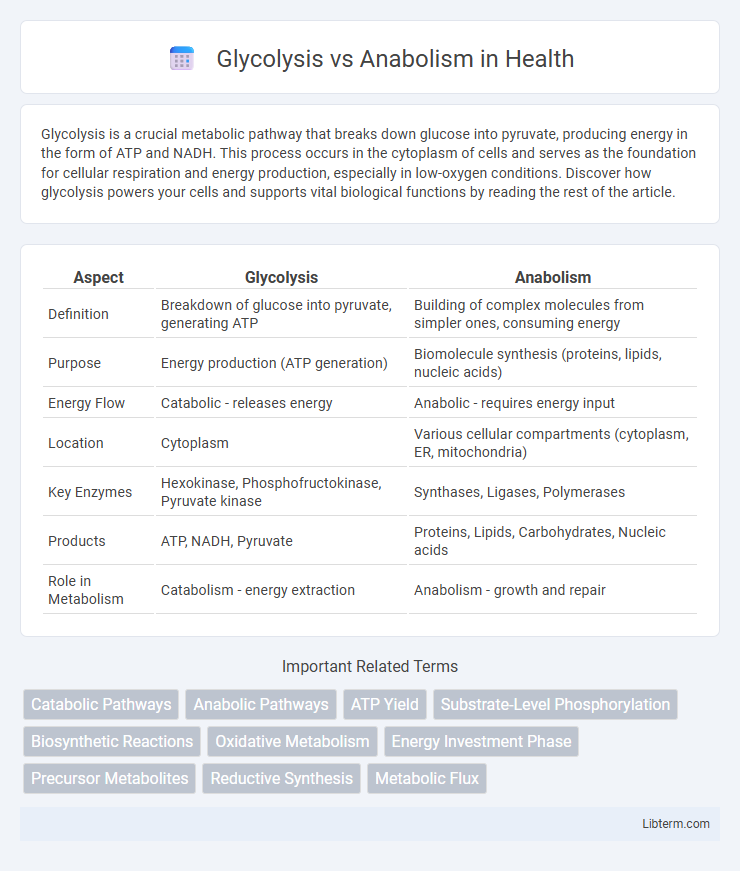Glycolysis is a crucial metabolic pathway that breaks down glucose into pyruvate, producing energy in the form of ATP and NADH. This process occurs in the cytoplasm of cells and serves as the foundation for cellular respiration and energy production, especially in low-oxygen conditions. Discover how glycolysis powers your cells and supports vital biological functions by reading the rest of the article.
Table of Comparison
| Aspect | Glycolysis | Anabolism |
|---|---|---|
| Definition | Breakdown of glucose into pyruvate, generating ATP | Building of complex molecules from simpler ones, consuming energy |
| Purpose | Energy production (ATP generation) | Biomolecule synthesis (proteins, lipids, nucleic acids) |
| Energy Flow | Catabolic - releases energy | Anabolic - requires energy input |
| Location | Cytoplasm | Various cellular compartments (cytoplasm, ER, mitochondria) |
| Key Enzymes | Hexokinase, Phosphofructokinase, Pyruvate kinase | Synthases, Ligases, Polymerases |
| Products | ATP, NADH, Pyruvate | Proteins, Lipids, Carbohydrates, Nucleic acids |
| Role in Metabolism | Catabolism - energy extraction | Anabolism - growth and repair |
Overview of Glycolysis and Anabolism
Glycolysis is a catabolic pathway that breaks down glucose into pyruvate, generating ATP and NADH to provide energy for cellular processes. Anabolism encompasses biosynthetic pathways that use energy and reducing power, such as ATP and NADPH, to build complex molecules like proteins, nucleic acids, and lipids from simpler precursors. These interconnected metabolic processes regulate cellular energy balance and macromolecule synthesis essential for growth and maintenance.
Defining Glycolysis: The Catabolic Pathway
Glycolysis is a catabolic pathway that breaks down glucose into pyruvate, generating ATP and NADH in the process, which provide energy for cellular activities. This metabolic route occurs in the cytoplasm of cells and serves as a primary step in energy extraction from carbohydrates. Unlike anabolism, which synthesizes complex molecules from simpler ones, glycolysis focuses on energy release through the degradation of glucose.
Exploring Anabolism: Building Biomolecules
Anabolism is the metabolic pathway responsible for synthesizing complex biomolecules from simpler precursors, essential for cell growth and repair. It utilizes energy-rich molecules such as ATP and NADPH to drive the formation of macromolecules including proteins, lipids, and nucleic acids. Unlike glycolysis, which breaks down glucose for energy release, anabolism focuses on energy consumption to build cellular components and maintain biological structure.
Key Enzymes in Glycolysis vs Anabolic Pathways
Key enzymes in glycolysis include hexokinase, phosphofructokinase-1, and pyruvate kinase, which regulate the breakdown of glucose into pyruvate while generating ATP and NADH. In anabolic pathways, enzymes such as acetyl-CoA carboxylase in fatty acid synthesis, glutamine synthetase in amino acid synthesis, and ribulose-1,5-bisphosphate carboxylase/oxygenase (RuBisCO) in photosynthesis drive biosynthetic processes that build complex molecules from simpler ones. The distinct regulation of these enzyme sets ensures metabolic balance between energy production and biomolecule assembly.
Energy Dynamics: ATP Generation and Consumption
Glycolysis is a catabolic pathway that generates ATP by breaking down glucose into pyruvate, producing a net gain of 2 ATP molecules per glucose molecule through substrate-level phosphorylation. Anabolism, on the other hand, consumes ATP to drive biosynthetic reactions, building complex molecules like proteins, lipids, and nucleic acids from simpler precursors. The energetic balance between glycolysis and anabolic pathways is crucial for cellular metabolism, as ATP produced during glycolysis fuels the energy-intensive processes of anabolism.
Regulatory Mechanisms in Glycolysis and Anabolism
Regulatory mechanisms in glycolysis primarily involve allosteric enzymes such as hexokinase, phosphofructokinase-1, and pyruvate kinase, which respond to energy charge indicators like ATP, AMP, and citrate to modulate metabolic flux. Anabolism is controlled by hormone signaling pathways, including insulin and glucagon, which regulate enzyme expression and activity to coordinate biosynthetic processes. Feedback inhibition and covalent modifications such as phosphorylation play crucial roles in balancing catabolic glycolysis with anabolic pathways for cellular homeostasis.
Interconnected Metabolic Pathways
Glycolysis, a catabolic pathway, breaks down glucose into pyruvate, generating ATP and NADH, which serve as essential intermediates for anabolic processes such as lipid and amino acid synthesis. Anabolism relies on glycolytic intermediates like glucose-6-phosphate and dihydroxyacetone phosphate to synthesize complex molecules, demonstrating the tight metabolic integration between energy production and biosynthesis. This interconnection ensures cellular homeostasis by balancing energy release and macromolecule construction for growth and repair.
Physiological Roles in Cellular Metabolism
Glycolysis plays a crucial role in cellular metabolism by breaking down glucose into pyruvate, generating ATP and NADH that fuel energy-demanding processes. Anabolism, in contrast, drives the biosynthesis of macromolecules such as proteins, lipids, and nucleic acids, supporting cell growth and repair. Together, these pathways maintain metabolic balance, enabling cells to efficiently manage energy production and biomolecule synthesis essential for physiological function.
Clinical Relevance: Disorders and Therapeutic Targets
Glycolysis dysregulation is implicated in disorders such as cancer, where enhanced glycolytic flux fuels tumor growth, and diabetes, characterized by impaired glucose metabolism. Anabolic pathway abnormalities contribute to metabolic diseases like obesity and fatty liver disease by promoting excessive biosynthesis of lipids and proteins. Targeting key enzymes in glycolysis, such as hexokinase and pyruvate kinase, alongside anabolic regulators like mTOR, offers promising therapeutic strategies for managing metabolic and proliferative disorders.
Summary: Distinguishing Glycolysis from Anabolism
Glycolysis is a catabolic pathway that breaks down glucose into pyruvate, generating ATP and NADH for cellular energy. Anabolism encompasses biosynthetic processes that build complex molecules from simpler ones, requiring energy input typically from ATP. The key distinction lies in glycolysis degrading substrates to release energy, whereas anabolism consumes energy to synthesize macromolecules essential for cell growth and maintenance.
Glycolysis Infographic

 libterm.com
libterm.com